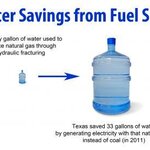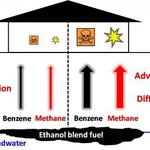Energy

What would you do if you were on a borehole drilling expedition and tapped into 1,000 degree Celcius magma at slightly over a mile deep?
Most people would run but the Icelandic Deep Drilling Project
at Krafla in 2009 felt a sense of accomplishment. It was only the second known instance of drilling onto magma (the first was in Hawaii in 2007 and there were on a search for high-temperature geothermal resources.
A steel casing, perforated in the bottom section closest to the magma, was cemented into the well and then the hole was then allowed to heat slowly and…

A new biofuel has been created from yeast and ordinary table sugar. The yeast produces oils and fats, known as lipids, that can be used in place of petroleum-derived products.
It has something everyone can love. And hate. It's a biofuel, which environments love, but the yeast has been genetically optimized, which environments hate. And it uses table sugar, which will make Mark Bittman and New York Times readers recoil in diet fad horror.
But the culture wars aside, the researchers' platform produces the highest concentration of oils and fats reported through fermentation, the…
When it was fashionable to do so, Germany claimed they were scuttling their nuclear power plants. Their energy companies, bolstered by billions of Euros in government subsidies, rushed to replace nuclear energy with solar and other alternative energy schemes.
But the projected increases in efficiencies never came to pass - companies that rely on subsidies are not in any rush to make technology better. And Germany has seen the US send its CO2 emissions from the energy sector drop back to early 1990s levels, and from dirty coal back to early 1980s levels, using natural gas - so now policymakers…

A new estimate has said that tidal power generated by turbines placed in the Pentland Firth, between mainland Scotland and Orkney, could power about half of Scotland - they estimate 1.9 gigawatts could be available.
The Pentland Firth is a prime candidate to house marine power projects because of its tidal currents, which are among the fastest in the British Isles. To exploit the Firth's full potential, turbines would need to be located across the entire width of the channel. In order to minimize the impacts on sea life and shipping trade, a number of individual sites have been…

Every child learns about photosynthesis, the process by which plants convert sunlight into energy.
It sounds simple but duplicating it elegantly remains one of the biggest challenges for chemists. Currently, the most efficient methods that we have of making fuel, like hydrogen, from sunlight and water involve expensive metal catalysts like platinum.
Argonne National Laboratory scientists have found a new, more efficient way to link a less expensive synthetic cobalt-containing catalyst to an organic light-sensitive molecule, called a chromophore. Cobalt is significantly less…

America is back at mid-1990s levels of carbon dioxide emissions. Some of that is due to the ongoing recession, of course, but a large chunk is due to the switch from the dirty coal plants that ballooned after America stopped producing emissions-free nuclear energy to natural gas.
While energy overall is back at early 1990s levels of emissions, coal specifically is back at early 1980s levels of emissions.
And it's all been done without mitigation, rationing or increased cost, even during a political climate of hostility against traditional energy. It isn't just CO2; "combined cycle" natural…

Methane hydrates are ice-like solid fuel composed of water and methane. And they are fragile. In some areas, such as in the North Atlantic off the coast of Svalbard, scientists have detected gas flares regularly and the reasons for their occurrence were unclear. They seem to only be stable at high pressure and low temperature.
If so, global warming might cause the dissolution of gas hydrates, according to an analysis led by scientists from GEOMAR Helmholtz Centre for Ocean Research Kiel who say that it is very likely that methane hydrate gas flares are caused by natural…

Texas, the U.S. state that annually generates the most electricity, has transitioned from coal to natural gas for electricity generation and that has not only reduced CO2 emissions but is saving water and making the state less vulnerable to drought.
Hydraulic fracturing - fracking - is a process in which water, sand and chemicals are pumped at high pressure into a well to fracture surrounding rocks and allow oil or gas to more easily flow. Hydraulic fracturing and horizontal drilling are the main drivers behind the current boom in U.S. natural gas production and the resulting drop in CO2…

Like most government spending programs, once environmental lobbyists got their way and renewable ethanol biofuels became mandated and subsidized, they have been difficult to eliminate.
Perhaps the news that blending more ethanol into fuel to supposedly cut air pollution from vehicles carries a hidden risk of toxic or even explosive gases in buildings may help.
Those problems would likely occur in buildings with cracked foundations that happen to be in the vicinity of fuel spills. Vapors that rise from contaminated groundwater can be sucked inside, according to Rice University…

A new solar panel design and ceramic material points the way to potentially providing sustainable power that can be price competitive and efficient. It also reaches a four-decade-old goal of discovering a bulk photovoltaic material that can harness energy from visible and infrared light, not just ultraviolet light.
Part of the reason solar panels have low efficiency is that the particles collected from the sun enter the solar cell and spread out in all directions. Getting them all to flow one direction typically requires layers of different channeling material. Each time the particles pass…